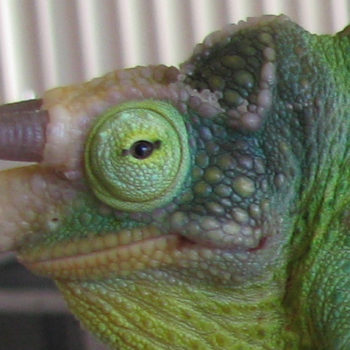Bacterial Infection
Description
Bacteria is all around us and constantly trying to break into our bodies. Our immune system fights bacteria back all day. But when the body is weakened by poor husbandry conditions or a nasty breech of the protective skin layer, bacteria can take hold and reproduce faster than the immune system can respond. This is what creates an infection.
Bacterial infections are deadly and, more than just cause puss and swelling, they can eat bone away.
Symptoms
Animal attack is easy to determine as damage is external. The chameleon may have a black diamond shaped outline as a result of another baby biting him in a cage scuffle. The chameleon may also, literally, being missing a limb. Rats can easily kill and eat a sleeping chameleon. An ant attack is always a danger as well. Keep in mind that these animals may be attracted to left over feeders and then happen upon the chameleon.
Keeping chameleons outdoors is very beneficial, but added risk comes with that. Birds, rats, opossums, raccoons, snakes, ants, and any number of other animals can wander by and, if your chameleon is sleeping on the side of the cage, it can be attacked.
The discolored yellow patch seen in the cheek area was a growing bacterial infection under the skin. Lacerating this “bubble” let a stream of puss out. A vet cleaned it out and provided antibiotics for a full recovery. But we were lucky that it expanded towards the skin and there was an external sign. The infection could have just as easily worked its way towards the inside eating through bone and body. The confusing symptom to interpret would have been the body shutting down. This infection came through an injury in the lower mouth.
Specific Bacterial Infections
There are a few bacterial infections that are significant enough that they have their own entry. Please reference the specific entry if your chameleons appear to have these types of bacterial infections.
Respiratory Infections
Respiratory infections are when a bacterial infection sets up in the respiratory system. The infection can make breathing harder and the tell tale symptoms start with the chameleon sticking its nose in the air and then it progresses to the chameleon open mouth breathing. As it advances, the eyes may get sunken in and then stay closed during the day. Click the image if this sounds like what you see.
Stomatitis (Mouth Rot)
Infections are always a danger in the mouth because that is where the prey killing is done and the prey tends to fight back. Any cut, bite, or damage to the teeth can provide an entry point for bacteria. There will often be a green or discolored puss around the teeth or wherever the infection has set in. Left unchecked, it can eat away the dental arcade leaving the chameleon without teeth.
Treatment
Treating a bacterial infection is always dual pronged. First, go see your veterinarian for antibiotics and, second, correct the condition which caused the weakened immune system to begin with.
Vet visit: A veterinarian is necessary for antibiotic treatment. Antibiotics are usually given in oral or injectable forms. The best way to go about treatment is to get the bacteria cultured and the correct antibiotic prescribed. Usually, though, the vet just prescribes a “broad spectrum” antibiotic that has a history of being effective with the most common strains. It is critical to follow through the entire antibiotic course even if improvement has been shown in order to reduce the chances of producing antibiotic resistant bacteria.
Investigation of Cause: The second part of treating an infection is to correct the cause. If the cause is not addressed then the infection will return. If the compromised immunity that allowed the bacteria to take hold was because of a substandard husbandry condition, that condition must be corrected.
Bacterial infections ave a great chance of recovery if they are caught early. The more advanced the infection the harder it is to beat it back.
This Meller’s Chameleon is showing acute internal distress. Although showing classic signs of respiratory infection, the chameleon did not respond to antibiotics. The lack of response could have been due to the antibiotic not being effective against this type or else this could have been a viral attack that was misdiagnosed as a bacterial infection.
This bacterial infection showed itself only as a slight puffiness in the casque which had the appearance of a fat pad. When taken to the vet to check to make sure it turned out to be a massive bacterial infection which had eaten downwards into the skull. The veterinarian removed the bacterial infection and cleaned out the wound leaving the huge hole as seen above. The chameleon survived and was active for a number of weeks afterwards, but eventually succumbed to the damage.












